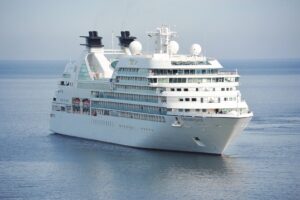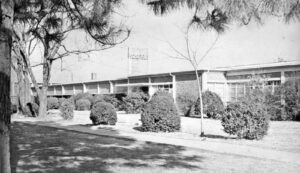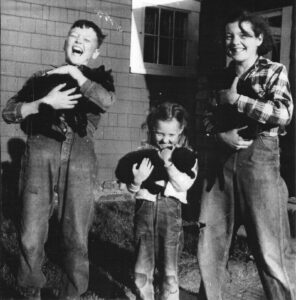
… in a town called Aiken
by Jeff Wallace
“The traffic is terrible. Have you ever seen it so bad? It took 20 minutes to get from Kroger to Target. Whiskey Road is awful.”
“You think the South Side is bad, let me tell you about downtown. There wasn’t a parking spot to be found on Laurens Street. And finding a place on Park Avenue left a two-block walk to my favorite restaurant. And then I had to wait 15 minutes to be seated. You’d think this was Columbia or Atlanta or Charleston.”
Life in a growing city is like that. We put up with more people, more traffic, longer lines, greater waits, and wonder how this has happened. But it wasn’t always this way.
ONCE UPON A TIME IN A TOWN CALLED AIKEN, the clinking of glass bottles could be heard on front porches as the milkman made his early-morning delivery. Mother had merely to go to the front of the house, push open the screen door and reach for the quart bottles with an inch of thick, rich cream floating on the top.
There was a Coca-Cola bottling plant in this town on York Street where the precious carbonated liquid was put into thick 6-ounce bottles that cost a nickel from the machines at every gas station. The building is now home to Aiken County’s Emergency services. Youngsters peered at the bottom of each bottle to read the city of origin. Lucky was the lad or gal who got to exclaim to friends, “Mine says Aiken, S.C.” Look up that bottle online today and it costs $12.75 – and that is without the Coke inside.
ONCE UPON A TIME there was an A&W Root Beer stand and that was followed by the Sno-Cap. Both had frosted mugs with sweet, frothy root beer to slake a young boy’s thirst. There was also the Hornet’s Nest at Rutland Drive and York Street (now a CVS store) where teens in the 1950s could go for after-school and post-football game sustenance.
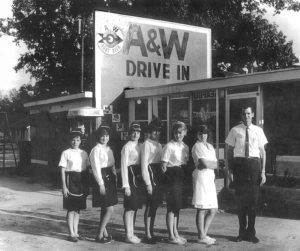
Aiken’s downtown was filled with familiar local names. Laurel, Buchanan, Franzblau, Persky, Coleman, Surasky, Efron and Hydrick adorned signs for businesses that included hardware, clothing, tires, shoes, groceries and appliances.
There were also chain stores downtown in Aiken, once upon a time. It was the site for Belk’s (now True Value Hardware) and White’s (near the Aiken Hotel) and B.C. Moore – department stores that had attire for everyone from baby brother to Granny. And there were A&P and Colonial grocery stores where Mother did her shopping.
As Aiken expanded, thanks in large part to the Savannah River Plant, both of those companies added stores to a growing South Side. In the new Mitchell Shopping Center, A&P and Colonial stood side-by-side with families choosing their favorite. Mother’s was Colonial, but A&P got the family’s best long-standing story.
We were living on Boardman Road at the time, with Mitchell Shopping Center just a short bike ride away. My two older brothers ventured out one day as Christmas was nearing and learned that A&P was having drawings for bags of oranges. One simply needed to fill out a form and place it in the entry box. The drawing was to be in the afternoon.
My clever siblings got fistfuls of entry blanks, filled them out and stuffed the box. When it came time for the drawings, their names came up time after time as winners. They gleefully accepted bag after bag of the citrus fruit until the manager finally said that enough was enough. They were disqualified from further winnings. We ate oranges for weeks.
ONCE UPON A TIME there were new schools being built in Aiken to accommodate the influx of students thanks to SRP. North Aiken, Eustis Park and Millbrook elementary schools went up with little thought about security as classroom doors led directly to outdoor sidewalks. Two walls of windows made it easy for inattentive students to daydream during lessons. And they provided perfect viewing stations for excited children when even a single flake of snow fluttered to the ground.
I watched Minnie B. Kennedy Junior High being erected across Pine Log Road from my classrooms at Millbrook. Perhaps I should have been paying more attention to my teacher, but watching the construction of the gym was a fascinating endeavor. A couple of years later I was in that gym doing calisthenics under the watchful eye of Jim Dawsey for P.E. class. Outside the fertile fields were cultivated on the far side of the campus, and 20 years later that land became home to South Aiken High, and Jim Dawsey became the principal.
Pine Log Road going east was once a two-lane road without the homes and businesses of today. The most notable landmark was the Robbins’ Trailer City water tower not far from Minnie B. That and the skeleton of a small cinder-block structure with a faded beer sign on the side were all that remained of a once-thriving community of approximately 1,000 trailers set up for hundreds of construction workers and their families.
ONCE UPON A TIME there was little to the south beyond the intersection of Whiskey and Pine Log roads. The Fox Drive-In, near the current southside Walmart, had its entrance not far from the connection of the two roads, and Coble Dairy was not too distant from that. The Bamboo Lounge, now a hair salon, and Aiken Bowl were a bit farther down the road. Being a youngster at the time, I had no notion of why people would want to stop at a lounge. Couldn’t they just go home and recline? The idea of a couple of beers after work did not connect.
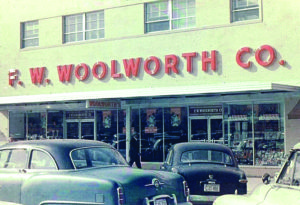
As for Aiken Bowl (the recently demolished Strike House), once upon a time there were three bowling facilities in town. The Southside’s lanes were the oldest, but there were also Park Avenue Lanes and Carolina Bowl. Now there are none operating in the city. Aiken Bowl during its infancy had pin boys who sat out of sight at the end of each lane. In days before automatic pin setters, it was their job to remove fallen pins and reset them after each frame. During my first attempt at the game, my pin boy had a job to be envied. I rolled a zero. All he had to do was send the ball back to me after each of my 20 gutter balls.
Once upon a time at the intersection of Richland and Hayne avenues there was a sign that read “Augusta 17.” From that point until one crossed the Fifth Street Bridge, there wasn’t a single traffic light. Now there are more than a dozen.
Aiken could have been called one of those sleepy, little Southern towns back then. Many businesses closed at noon on Wednesday, leaving shoppers with a brief window of opportunity on “Hump Day.”
Sundays were even more subdued with almost no stores open during the time of Blue Laws that prohibited the sale of many items. Worshippers at Aiken’s many churches were the only ones out and about in the morning, and going on a Sunday drive was a common event for many families.
ONCE UPON A TIME in Aiken, if you wanted to go out for a good meal, it involved a trip across the Savannah River. There weren’t restaurants in town open for evening fare as there are today.
And one did not have to worry about finding a parking place downtown. It was not unusual for a customer to find a spot directly in front of the store she was intending to visit. Rows of parking meters stood at attention downtown, requiring the deposit of a penny for every 12 minutes.
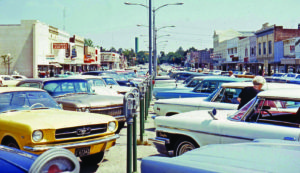
After-sunset parking on Laurens Street is an issue today as the restaurants and night spots beckon a growing number of people to enjoy the amenities of a vibrant downtown. But once upon a time in downtown, it was rare to find a vehicle parked on Laurens after dark. Those few cars remaining were either abandoned or wouldn’t start. There were no open businesses to visit.
For youngsters with a few coins in their pockets, downtown was a great place to be. There weren’t the boutiques and specialty shops of today, but there were three five-and-dime stores. Mack’s and McCrory’s stood side-by-side on the east side of Laurens Street, while Woolworth’s faced them from the opposite side. Their soda fountains were a big draw on allowance day.
Those stores sold small personal items, fabric, thread, toys and penny candy. I preferred looking at the toys and candy. The five and dime stores are long gone today, their genre replaced by the dollar stores sprinkled around the county’s landscape.
ONCE UPON A TIME in Aiken, Teen Town stood behind the Aiken County Hospital. Friday night football games were concluded with dances at the one-story structure that now houses Aiken Senior Life Services. Perhaps the transition from a teen center to a senior center is appropriate for the youth of that era.
Aiken had no college until 1961 when USC Aiken was established as a two-year campus in a renovated mansion on Newberry Street. Classes were held in former bedrooms, a ballroom served as a central point for meeting, and students gathered in a lounge located in the basement.
The college became a four-year school and now serves a thriving student body in more than a dozen buildings on Aiken’s western edge. The mansion/college later became Aiken’s library and now stands as the Aiken County Historical Museum. The library moved to the building formerly known as The Aiken Institute (Aiken’s first public school) and later as Aiken Elementary, on the corner of Whiskey Road and South Boundary.
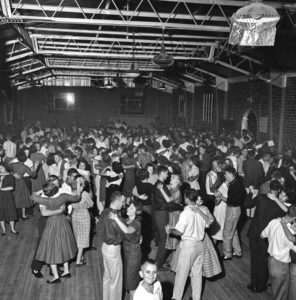
There were once two movie theaters downtown, and then more were added prior to the construction of the facility at Aiken Mall. The Rosemary and Patricia were located on Laurens Street. The Cinema Triple was later built at what was the Rosemary site, offering viewers three options for viewing when they purchased tickets. That site now holds a plush condo building above the Meybohm Realty offices. The old Patricia Theater that used to show double features every Saturday is now the RE/MAX Tattersall Group office. The Mark I was built on Newberry Street where the Aiken Community Theatre stage now stands.
Yes, once upon a time in Aiken things were different than they are now. There wasn’t as much traffic. There weren’t as many people. Folks did not come here to retire; those who retired had spent their working careers here. There was a different way of life.
Having lived in this city for more than 60 years, I have seen lots of changes, not all of which I like. But the same was said by those who lived here when my family arrived. Those folks who grew up in the pre-Savannah River Plant Aiken saw changes they had not sought. They grudgingly accepted the new face of their community, something those of my generation who have spent a lifetime here are doing now.
Change comes, and while we can sit dreaming of a past that will never return, our energies are best served making this city the best it can be today.
Fairy tales that begin with “once upon a time” usually conclude with “and they lived happily ever after.” The struggle to find “happily ever after” is a never-ending one for a city like Aiken, but it is fun to look back from time to time and remember what this place looked like “once upon a time.”
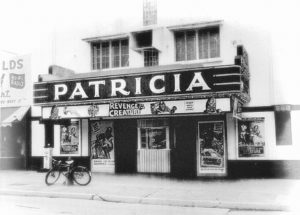
––––––––––––––––––––––––––––––––––––––––––––––––––––––––––––––––––––––––––––––

Jeff Wallace has lived in Aiken for more than 65 years. He is a retired editor of the Aiken Standard, has taught in the Aiken public schools, and is currently an adjunct faculty member at USC Aiken. He and his wife Mary Lou have three daughters and seven grandchildren.

